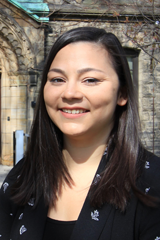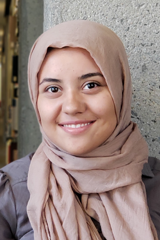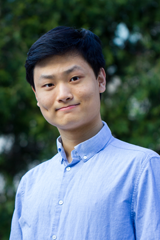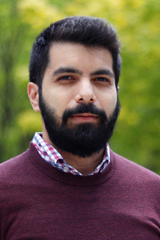Meet some of the 2021 recipients of Canada’s most prestigious graduate awards, exemplifying academic excellence across the full range of disciplines.
 Anish Arora, Family Medicine
Anish Arora, Family Medicine
Co-Developing & Piloting a New Model of Care Delivery for Migrant People Living with HIV in Montréal.
Anish Arora is a PhD student in family medicine and primary care at McGill University. He holds an MSc specialized in medical education from McGill University and an Honours BSc in biology with a minor in psychology from McMaster University. His doctoral work, supervised by Dr. Bertrand Lebouché, focuses on configuring and piloting a smartphone-based patient portal application, OPAL, for use by migrant people living with HIV and their multidisciplinary care providers at the Chronic Viral Illness Service of the McGill University Health Centre. As part of a new digital model of HIV care delivery, OPAL is predicted to improve HIV self-management by migrant patients, reduce impediments to their retention in care, and improve their satisfaction with care. Alongside mixed methods, Anish adopts a participatory research approach to meaningfully engage patients and other stakeholders in his work.
 Julia Baak, Natural Resource Science
Julia Baak, Natural Resource Science
Using movement ecology to quantify biotransport of plastics and plastic-related contaminants into the Arctic by gulls.
Almost half of seabird species worldwide ingest plastic, even in remote regions such as the Arctic. Plastic pollution can have physical impacts on seabirds through ingestion and entanglement, but can also be a source of contaminants, such as flame retardants. As top predators, seabirds can be used as indicators of plastics and plastic-related contaminants in the marine environment. Glaucous gulls and black-legged kittiwakes are circumpolar Arctic seabirds that are used as indicators of contaminants in northern wildlife, but data are limited for both species in the Arctic, at a time when human activity is growing in these regions, increasing exposure to contaminants. My research investigates the quantity, transport and impacts of plastic and plastic-related contaminants on Arctic gulls. My research will create a baseline for monitoring plastic pollution in Arctic seabirds, identify potential hotspots for this environmental contaminant, and assess how plastic pollution impacts seabirds in a rapidly changing Arctic.
 Robert Bogue, Earth and Planetary Sciences
Robert Bogue, Earth and Planetary Sciences
Volcanic ecosystems: recorders of the past, glimpses of the future.
As magma rises through Earth’s crust it releases large amounts of carbon dioxide gas, which is transmitted to the surface along fault lines and eventually released into the atmosphere. These gas emissions can provide crucial information about volcanic activity, but they are often difficult to measure because they can be spread out over large areas and are difficult to detect directly with satellites. Trees growing on volcanoes are exposed to this volcanic carbon dioxide and utilize it for photosynthesis. My research focuses on using multiple approaches to detect tree responses to volcanic carbon dioxide as a proxy for volcanic activity, and to understand how ecosystems may respond to rising levels of atmospheric carbon dioxide in the future. My projects range from satellite detection of vegetation health in hydrothermal areas of Yellowstone to reconstructing decades of carbon dioxide emissions by measuring variations in carbon isotopes in tree samples from Ecuador.
(Photo courtesy of Regina Gonzalez Moguel)
 Jonathan Brassard, Biological and Biomedical Engineering
Jonathan Brassard, Biological and Biomedical Engineering
Fabrication of a vascularized bioartificial pancreas using macroencapsulation of stem cell-derived pancreatic islet cells for the treatment of type 1 Diabetes.
Type 1 diabetes affects more than 300 000 Canadians and its impact continues to rise in Canada and the world. Transplantation of pancreatic islets is a promising strategy to treat diabetic patients because it can eliminate their dependence on external insulin sources for many months. A critical problem with this approach is graft rejection, a process where your own immune system attacks the newly transplanted tissue and destroys it. To address this issue, we are fabricating a small device that can encapsulate islets and protect them from immune destruction. To optimize survival of the graft, our device contains hollow channels that can enhanced diffusion of nutrients after transplantation. With our approach, the islets inside the device will take on the function of the patient’s failing pancreas, producing the insulin needed to regulate blood sugar level.
 Emmalin Buajitti, Epidemiology, Biostatistics and Occupational Health
Emmalin Buajitti, Epidemiology, Biostatistics and Occupational Health
Neighbourhood environmental exposures and their associated health risks: evidence and policy implications for urban health and health equity from Accra, Ghana.
In settings undergoing rapid development, features of the urban neighborhood environment may be implicated in worsening health inequalities as cities expand and the urban poor become increasingly dispossessed. Policymakers in those cities, such as Accra, Ghana, face a growing need for evidence to support healthy and equitable development. My research will focus on identifying risk factors in the neighborhood environment that can be targeted to improve population health and reduce health inequalities in Accra. I will use methods from epidemiology and geography to generate empirical evidence about neighborhoods and their role in urban health. In partnership with policymakers and other local experts, I will support the co-creation of viable, innovative policy solutions with the potential to improve the neighbourhood environment and build healthier and more equitable cities around the world.
(Photo courtesy of Rae L. Jewett)
 Luisa Castaneda Quintana, Law
Luisa Castaneda Quintana, Law
Extracting culture: the reshaping of Wiwa people’s identity in the Sierra Nevada de Santa Marta.
Luisa Castaneda-Quintana is a Colombian lawyer with a master's degree in Administrative Law from the Libre University in Colombia and an LLM in Comparative Law and Economics from the University of Turin and IUC in Italy. Castaneda-Quintana's doctoral thesis, supervised by Professor Victor Muniz-Fraticelli, is tentatively entitled: Extracting culture: the reshaping of Wiwa people’s identity in the Sierra Nevada de Santa Marta. The doctoral work focuses on legal pluralism, extractive industries, and Indigenous Peoples' identity. Specifically, she analyzes how the Wiwa people's interactions with different normative orders in the context of extractivism have transformed their identity and forged various forms of resistance.
(Photo courtesy of Julian Hernández)
 Jeremy Desjarlais, English
Jeremy Desjarlais, English
Being and Longing: The Ontology of Linguistics and Reconciliation in Indigenous and Canadian Long Poetry
Indigenous and Canadian peoples are eager for a literature that responds to the Calls to Action of the Truth and Reconciliation Commission of Canada, as a means of validating and authenticating its recommendations. A report from the Commission unwaveringly states: “The urgent need for reconciliation runs deep in Canada” (114). My dissertation combines Canadian long poets of Indigenous and non-Indigenous heritage—Louise Bernice Halfe, Jordan Abel, bpNichol, and Steven Ross Smith—for the purposes of examining the development and lineage of the contemporary long poem. Through the theme of reconciliation, these poets address issues of ontology and demonstrate the presence of longing through language. The length, immensity, and enormity of these vast works permit the deepest elements of being: language, expression, and the emotional aspects of existence (longing, loss, desire, compulsion). Undergirding all of these poets’ works is a longing to reconcile, on an individual, communal, and national level.
 Arna Ghosh, Computer Science
Arna Ghosh, Computer Science
A Biologically-plausible Deep Learning framework to model self-supervised learning in the visual cortex.
My research broadly aims to bridge the gap between artificial intelligence (AI) systems and the brain. Despite the remarkable progress in the fields of computer vision, current AI systems fail to match the ability of brains to learn from limited amounts of labelled data, thus restricting the applications of modern AI in various promising domains like healthcare. My research aims to develop biologically inspired systems that can mimic the brain’s ability to learn from unlabeled data, i.e. perform self-supervised learning. Specifically, we aim to imbibe the predictive coding principle in AI models, such that the system is able to make predictions of upcoming stimulus given its current belief about the environment. Furthermore, we aim to develop learning rules that are feasible in biological systems. In doing so, we hope to develop a biologically plausible learning framework that can be used by neuroscientists to improve our understanding of the brain.
(Photo courtesy of Zahraa Chorghay)
 Victoria Glynn, Biology
Victoria Glynn, Biology
Host-microbe co-evolution in Tropical Eastern Pacific corals as a potential source of resilience to environmental stress.
Due to climate change, one-third of coral species risk extinction by the end of this century. Coral reefs are one of the most biodiverse ecosystems on Earth, supporting over 25% of marine life. Within a single coral polyp, all domains of life can be found in symbiosis with coral, such as bacteria, viruses, and fungi. I use Panama’s Tropical Eastern Pacific (TEP) as a natural laboratory to assess coral resilience from the perspective of host-microbe co-evolution, as here corals experience drastic annual fluctuations in temperature, pH, oxygen, and nutrients, due to seasonal upwelling; upwelling is when cold, nutrient-rich water displaces warmer, less nutrient-rich surface water. As such, the TEP’s ecologically-dominant coral species, Pocillopora damicornis, persists under conditions expected to mirror future environments. My research is the first to employ Panama’s upwelling gradient to discern the strategies corals and their microorganisms can implement to persist in a warmer, high CO2 future.
 Yeganeh, Habibi, Chemistry
Yeganeh, Habibi, Chemistry
Shedding Light on Novel Antibiotic Discovery: Investigating the Relationship of Structural Dynamics and Catalytic Function in Lanthipeptide Synthetases, Enzymes Involved in Antibiotic Synthesis.
Shortly after the widespread introduction of antibiotics into clinical practice in the 1940s, the bacterial pathogens that cause sickness in humans began evolving resistance mechanisms that render antibiotics ineffective, leading to a global health crisis. Fortunately, nature offers many potential solutions to this problem. Indeed, most of the antibiotics used for medicinal purposes in humans are chemical compounds produced by living organisms as molecules for self-defence. These “natural products” often have highly complex and ornate chemical structures that can make chemical synthesis of the compound difficult. However, the biosynthetic enzymes that construct natural products in the producing organism often do so with astounding catalytic efficiency and specificity. My research aims to understand – on a molecular level – how these enzyme catalysts synthesize antimicrobial natural products. This information can ultimately assist in the design of catalysts and biosynthetic pathways that construct novel antibacterial compounds using renewable natural resources.
(Photo courtesy of Ehsan Hamzehpoor)
Anna Halepaska, Civil and Mechanical Engineering
Integrated biomaterials for net carbon storage in buildings.
 Alberto Herrero Babiloni, Experimental Medicine
Alberto Herrero Babiloni, Experimental Medicine
Acute effects of non-invasive repetitive transcranial magnetic stimulation (rTMS) in the management of chronic orofacial pain and problematic opioid use.
Temporomandibular joint disorders (TMD) are common chronic pain conditions of the face and jaw that impact significantly the well-being and quality of life of people suffering from them. Chronic TMD pain is challenging to treat, and many patients do not respond well to usual treatments. Moreover, medications such as opioids are associated with different risks and side-effects. In this project, “Repetitive transcranial magnetic stimulation” (rTMS), a safe and non-invasive technique used to stimulate the brain and potentially change neurons, will be used attempting to decrease pain and deleterious opioid outcomes. We expect that rTMS decreases pain intensity, pain interference, and opioid problems such as craving, withdrawal and misuse in TMD participants. This project is novel and important, as its findings could support the use of a new and safe treatment for improving pain, opioid problems, and suffering associated to TMD.
(Photo courtesy of Natalia Cordero)
 Suleima Jacob-Tomas, Biochemistry
Suleima Jacob-Tomas, Biochemistry
Uncovering mechanisms to tune local translation during neurodevelopment.
Neurodevelopment encompasses multiple changes in the architecture and composition of neurons, which are fundamental to establish functional circuits in the mature brain. This complex process requires each neuron to compartmentalize functions. The creation of diverse functional hubs relies on a decentralized gene expression system. Consequently, messenger RNAs are transported to different compartments to be locally translated into proteins, the functional molecules in cells. Even so, how components of the translation machinery regulate their local production to support protein synthesis is not known.
My doctoral research aims to study the local production of the protein synthesis machinery in the developing neuron using single molecule fluorescence microscopy techniques. Regulating the localization and local translation of mRNAs encoding for translation factors provides the means to address neuronal compartmentalization during development. We expect to uncover novel molecular basis to understand neuronal functionality in the adult brain.
(Photo courtesy of Lokha Ranjani Alagar Boopathy)
 Amanda Keller, Social Work
Amanda Keller, Social Work
Life after residential care: a retrospective narrative analysis project examining the life stories of those who aged out of youth protection-based residential care in later adulthood.
I have an academic interest in multiple domains across the social service and mental health care systems, with a particular interest in examining clinical interventions for childhood trauma. My dissertation employs narrative analysis with a feminist and strengths-based perspective to investigate the life trajectories of adults age 40+ raised in group-care child welfare placements. I am to document the actual and complete transition to adulthood and provide insights into their difficulties and clinical needs across the lifespan while sharing their stories for social justice purposes. Because of the well-known intergenerational transference of trauma, this exploratory study will likely capture other insights beyond its central focus, including the research participants’ interactions with parenting and their families of origin. This novel inquiry on life development is the second study to my knowledge, which examines this age group's insights and the first within Canada.
 Marjolaine Lamontagne, Political Science
Marjolaine Lamontagne, Political Science
State Sovereignty in Practice: the Paradiplomatic Practices of Non-Sovereign Representatives in Multilateral Fields.
Who speaks on behalf of citizens internationally? If the coronavirus pandemic has shown us anything, it is that regional and federated governments are constitutionally responsible for, and hold distinctive views on, a great number of global issues, including healthcare, environmental politics, and the protection of cultural diversity. Yet, international law excludes them from multilateral organizations where global debates are held, and national and multilateral officials are reluctant to acknowledge their growing participation in international politics.
My thesis research will investigate the transformation of diplomatic practices in multilateral organizations and forums where substate actors increasingly assume a formal and informal presence. Among other methods, I will interview diplomatic representatives from substate and national governments to apprehend the informal “ways of doing things” and “background assumptions” that contribute to the reproduction of state sovereignty beyond institutions and political discourse. The goal will be to examine if and how the balance of political legitimacy and the distribution of diplomatic tasks between central and substate governments are changing in the era of globalization, and what are the effects of this transition on global and national governance.
 Chenghao Liu, Chemistry
Chenghao Liu, Chemistry
Exploring the Third Dimension in Two-dimensional Polymers.
Two-dimensional materials are as thin as an atom. They are one of the fastest-growing fields in materials science upholding promises for revolutionary technologies in semiconductors, energy storage, catalysis, and beyond. Organic 2D materials are particularly promising where the vast chemical space of molecular building blocks offers wide tunability of their electronic, magnetic, and optical properties. My research aims to systematically elucidate how electronic properties arise in organic 2D materials and the design thereof. Focusing on the supramolecular influences, I seek to develop weak chemical interactions for inducing strong electronic effects with the objective of creating new classes of materials with unchartered physical phenomena.
(Photo courtesy of Zhechang He)
 Tianyuan Lu, Quantitative Life Sciences
Tianyuan Lu, Quantitative Life Sciences
Multi-ethnic polygenic risk scores to improve risk screening of complex diseases for populations of non-European ancestries.
Accurately quantifying genetic risk towards complex diseases is important to health care. Recent advances in human genetics have enabled development of genetic risk scores with potential clinical utility in identifying individuals at an elevated level of risk.
However, most of these advances have occurred using data from individuals of European ancestry. In contrast, the predictive performance of genetic risk scores is substantially attenuated in populations of other genetic ancestries. Consequently, there are no clinically-acceptable polygenic risk scores available to these populations, who make up very important proportions of the population of Canada and of many other countries while supporting the health care system and its patients.
Therefore, we aim to develop novel statistical learning methods to improve genetic risk prediction of complex diseases in diverse ancestry populations. These approaches will help not only realize the goals of generalizability and clinical utility, but also mitigate long-standing health care disparities.
(Photo courtesy of Wenmin Zhang)
 Mathis Messager, Geography
Mathis Messager, Geography
Advancing environmental flow science for intermittent river management.
My research seeks to inform the management and conservation of freshwater ecosystems and, in turn, support human cultures and livelihoods that depend on these ecosystems. I take a multidisciplinary approach, leveraging ecology and geosciences, together with the most recent advances in statistics and computing, to promote freshwater sustainability.
Through my doctoral work, I focus on improving our understanding and promote the conservation of rivers that flow only part of the year. From Himalayan snow-fed creeks and Saharan wadis, to small streams in British Columbian rainforests, most rivers and streams on Earth flow only part of the year, yet we know very little about them. This oversight contributes to the degradation of these ecosystems, the main source of water and livelihood for millions of people. Through my thesis, I intend to correct this oversight and enable their conservation.
(Photo courtesy of Olivia del Giorgio)
 Muhammad Ghufran Rafique, Chemistry
Muhammad Ghufran Rafique, Chemistry
Sequence-defined DNA-based pi-conjugated polymers as cellular transmembrane nano-bioelectronic sensors.
The integration of electronics with biological systems and living matter for therapeutic, diagnostic, and biosensing applications is an emerging challenge in nanoscience. Current approaches, however, are limited by both the size and material mismatch between ‘hard’ silicon-based electronics and ‘soft’ organic matter such as tissues and cells.
My research will address this challenge by combining customized semi-conducting organic molecules called π-CMs (conjugated molecules) with DNA – a programmable biomolecule capable of biochemical recognition – to yield bio-electronic polymers. These polymers will have precise and tunable lengths, sequences, and electronic properties, and will thus assemble predictably inside cell membranes. They will thus serve as two-component, transmembrane nano-biosensors: the DNA component will recognize a biochemical stimulus causing the polymer to adjust its position inside the cell membrane. This will cause a transient change in the electronic properties of the π-CM component which will then be detected externally.
Such nano-biosensors would allow the interfacing of cells and even microorganisms such as bacteria with non-invasive, macroscopic measurement tools without the need to embed silicon-based electronics in the biological environment. This seamless integration of molecular biological systems with molecular electronics signifies another revolution in modern electronics at the nanoscale regime, and will contribute to the field of diagnostics and the development of emergent technologies such as microbial fuel-cells.
(Photo courtesy of Fangzhou Zhao)
 Mehak Sawhney, Art History and Communication Studies
Mehak Sawhney, Art History and Communication Studies
Mapping the Rise of Surveillance Technologies, the Far Right, and State Violence in India.
My PhD research at McGill University focuses on the technological and political aspects of audio surveillance in India. Through an ethnographic and historical study of sonic surveillance technologies such as telephony and radio communications in postcolonial India, it aims to understand how technology, law and listening practices facilitate state oppression. While the scholarship on surveillance has largely focussed on documentary, visual, and biometric identification, my project aims to explore the sonic dimensions of surveillance in the global South. More broadly, my research interests lie at the intersection of sound and media cultures of South Asia. I have previously researched on the politics of machine listening and urban sound.
 Michelle Smith, Integrated Studies in Education
Michelle Smith, Integrated Studies in Education
Michelle Smith is an award-winning Métis filmmaker, media artist and educator born and raised in St. James, Manitoba. She obtained her BA Honours from McGill and MA in Media Studies from Concordia University where she received the Sony Graduate Award. She has directed and produced numerous documentary films and interactive media on issues of Indigenous identity and resurgence, education and intercultural experience. She coordinated and taught in the Journeys First Peoples Transition program at Dawson College in Tiohtiá:ke (Montreal) for four years. She is a founding member of the Dawson First Peoples Initiative, Indigenous Education Council and Intercollegiate Decolonizing Network and teaches Cinema-Communications at Dawson College. She is Principal Investigator for the First Peoples Post-Secondary Storytelling Exchange (fppse.net) supported by SSHRC’s (CCSIF). She is pursuing a PhD in Education at McGill, with a focus on Indigenous educational sovereignty.
 Hilary Sweatman, Integrated Program in Neuroscience
Hilary Sweatman, Integrated Program in Neuroscience
Episodic memory and theory-of-mind in children with autism.
We use memory of our past experiences to imagine what other people are thinking. Being aware of other’s mental states is crucial for successful social interactions. In autism, detailed memory of past experiences is commonly impaired, along with the ability to imagine what others are thinking. Together, these challenges may create difficulty when conversing with others, providing a potential explanation for the social impairments commonly seen in autism. Memory deficits may be due to the fact that people with autism have difficulty relating experiences to themselves, a phenomenon which normally boosts memory. Using neuroimaging techniques, we aim to see how the effect of relating memories to oneself differs in children with autism compared to typically developing children. This will aid in understanding the roots of social impairments as they exist in the brain and behavior in autism and will inform future interventions to improve day-to-day interactions for these individuals.
 Motahareh Vameghestahbanati, Experimental Medicine
Motahareh Vameghestahbanati, Experimental Medicine
Chronic Obstructive Pulmonary Disease and Dysanapsis.
Chronic obstructive pulmonary disease (COPD) is a leading cause of death and disability in the world and in Canada. Although smoking is the main risk factor, only a minority of smokers develop COPD and people who had never smoked can also develop COPD, suggesting that other risk factors must exist. 50 years ago, scientists using simple tests that measure lung function, speculated that some people have undersized airways relative to the volume of their lungs. This size mismatch was termed dysanapsis and is believed to develop early in life when airway branches grow more slowly than lung volume. Recently, by measuring airway tree size using computed tomography, our team showed that people with dysanapsis are eight times more likely to develop COPD. Thus, dysanapsis is a major COPD risk factor. By integrating methods of population-based epidemiology, state-of-the-art-imaging, and physiology we aim to understand clinical outcomes of dysanapsis and unravel targetable mechanisms of functional impairment.
 Heather Whittaker, Neurology and Neurosurgery
Heather Whittaker, Neurology and Neurosurgery
Neuromodulation with cognitive training to enhance working memory.
I study brain stimulation as a tool to improve memory in people with cognitive deficits. My research combines transcranial magnetic stimulation (TMS) with a brain training program that strengthens auditory working memory, which is the ability to remember and manipulate sounds. When rhythmic pulses of TMS are applied at the same frequency, timing, and location of the brain waves that an individual naturally generates during working memory task performance, the brain waves synchronize to the stimulation. People who display more oscillatory synchronization perform better on the task. I am investigating whether this performance enhancement is long lasting and can generalize to other cognitive tasks. This project aims to shed light on the neural mechanisms of brain wave entrainment, and potentially open a new therapeutic avenue for cognitive decline. In the future, people with cognitive deficits could rehabilitate their working memory using combined brain training and stimulation.
(Photo courtesy of Khalid Hossain)
 Eric Wilkinson, Philosophy
Eric Wilkinson, Philosophy
Intuition and the Acquisition of Moral Knowledge.
In ethical philosophy, intuitions are often considered a source of moral knowledge. Contemplating a morally charged situation elicits an ‘intuition’ about what the right or wrong thing to do is in that situation. This intuition is a starting point for rational reflection, and thus the first step to acquiring moral knowledge. However, there is no agreement on what intuitions are or how they justify moral beliefs. My research aims to clarify the nature of intuitions, and how they offer a priori knowledge.
In addition to answering the epistemic question of how ethical intuitions justify moral beliefs, my work also examines the ontological implications intuitionism has regarding the existence of moral properties, and the question of what psychological mechanism is used to acquire moral knowledge. Outlining the foundation for moral theorizing benefits anyone working on ethical philosophy, and is also relevant to those in other disciplines and non-academics who must form ethical judgments.
(Photo courtesy of Kate Fellerath)
 Melanie Wisener, Educational and Counselling Psychology
Melanie Wisener, Educational and Counselling Psychology
Title
Using alcohol and/or marijuana in attempt to alleviate negative emotions has been consistently associated with alcohol and/or marijuana-related problems in undergraduate students. Theory suggests individuals use substances in attempt to alleviate negative emotions when they lack alternate means of coping. Thus, investigating alternate coping strategies, such as mindfulness and self-compassion, may afford a unique opportunity to address coping-motivated alcohol and marijuana use and the associated problems on Canadian university campuses.
My proposed three-part Doctoral dissertation aims to develop, evaluate, and disseminate a brief mindfulness and self-compassion program aimed at reducing coping-motivated use and the associated problems in undergraduates. Teaching mindfulness and self-compassion as alternate coping strategies to alcohol and/or marijuana use may help reduce coping-motivated use and the associated problems on Canadian university campuses. This would directly benefit the students using alcohol and/or marijuana, their fellow students, and their university.
 This work is licensed under a
This work is licensed under a